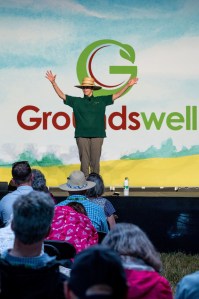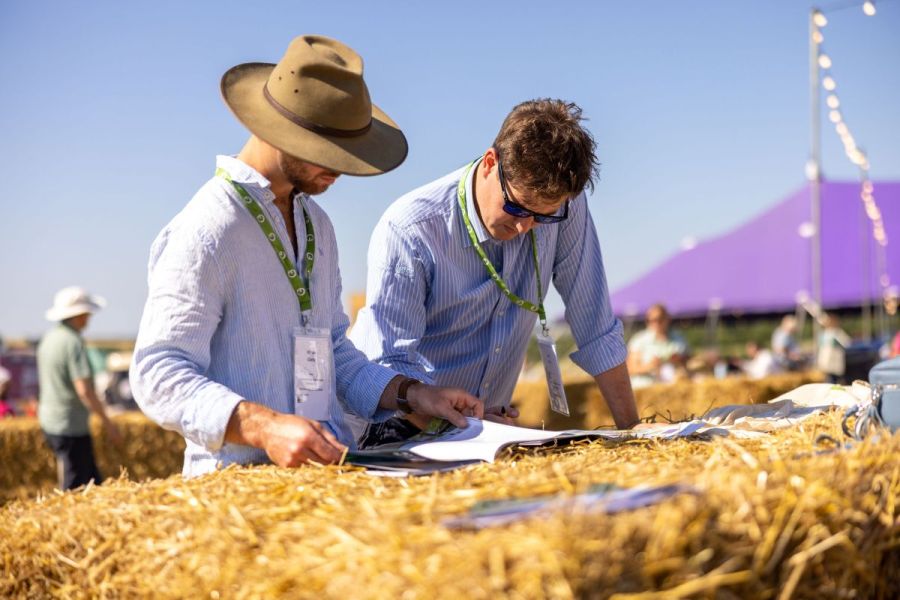The diverse programme of talks at Groundswell didn’t disappoint, with most tents full to capacity from the first to the last talk on both days. CPM brings together some of the highlights from regenerative agriculture’s thought-provoking event.
One thing’s for sure, regen ag is going to be the new conventional.
By Lucy de la Pasture and Melanie Jenkins
Boundless blue skies welcomed visitors to the Groundswell event at Lannock Manor Farm near Hitchin in Hertfordshire last month. With more than 5000 people through the gate on day one, there was standing room only for many of the sessions taking place across the showground.
Sunnies, shorts, ice creams and refillable water bottles were definitely the order of the day to help survive the heat but it didn’t subdue the audience, even in the sweltering Big Top where some of the legends of regenerative agriculture shared the programme with policy makers, politicians and discussions around carbon. There really was something for everyone on offer.
First principles
Cambridgeshire farmer Tom Martin entertained a packed out Agricology tent as he shared, not just the mistakes he’s made adopting regenerative principles, but those of other well-known farmers.
“If you’re not making mistakes then you’re not making progress,” he says, borrowing the quote from Phil Needham, who he’d heard speaking in Kentucky.
“I went to that conference as a slightly cocky, certainly very excited and confident Englishman. I was the only one among 600 farmers. I had the Groundswell T-shirt and knew about the five principles of regenerative farming.
“So I heard a talk from Rick Clark, a fantastic farmer. He’s actually reduced his inputs by $1.1 million in the past few years. And he spoke about the principles of regenerative farming.
“He started off talking about the six pillars of regenerative farming and said ‘of course everyone knows this’. And I thought, well, that’s the only thing I know about and it turns out I’m wrong. So now there are six pillars of regenerative farming…”
Rick Clark’s sixth pillar is context, explains Tom, and he says it’s something he could have done with understanding when he began his regen journey.

From first principles to the policy to support it, the Groundswell event is fundamentally all about the soil.
“The more I think about context, the more I realise some of the errors that I’ve made have been based on context. And really, I would summarise that by saying that ‘copy and paste’ farming absolutely does not work. Just because something works on my neighbour’s farm, it may well not work on mine.”
Tom says he began by doing everything at once – direct drilling, planting cover crops etc – but it was out of context. He used drainage as an example, something he’d set out to try and improve but he’d adopted a copy and paste approach.
“We’ve got a little bit of skirt land where there’s a top of the old riverbank and a peaty bit at the bottom. So I took the mole drainer through it. I thought, I need to sort out my drainage.
“And of course, what I did was take all the water off the heavy land on the top of the ditch and I put it straight into the peat lands at the bottom of the old riverbank. You know, I thought about drainage. I’ve done what I should do but I copy and pasted it. And they called it Tom’s Nature Reserve because for three winters we had ducks and geese on the lake I’d created there.”
Tom went on to illustrate how he and other well-known farmers, including Tom Jewers, Martin Lines and David Lord, have all made mistakes across the five principles of regen ag, particularly with drainage, trash management, establishment and weed control.
“I’ve even done such a good job of protecting my soil that I protected it from the following seed that I’ve been trying to plant as well,” smiles Tom, discussing the effect of trash when trying to establish the following crop.
“So if you’re just coming into regen ag, if you’re looking to change your system a little bit, think about drainage and residues. But, as you know, some farmers I’ve really looked up to have and still have real headaches with these issues on their farms.”
Tom’s final bit of advice is to “keep the main thing, the main thing,” revealing that ‘focus’ is actually Rick Clarke’s seventh pillar of regen ag.
“One of the joys of trying to farm regeneratively is we’re grappling with things and constantly being challenged, constantly thinking and constantly learning. It’s very easy to take our eye off the ball. But the main thing is to keep the main focus, the main thing.
“It’s so valuable to share what we’ve got wrong, because experience comes just after you need it.”
Soil wellness
Dr Jill Clapperton returned to headline at Groundswell this year, drawing crowds to the Big Top on both days of the event to learn more about some of the first principles of regen ag in her high energy talk ‘Creating healthy productive soils that grows nutritious food’ and to demonstrate the rainfall simulator.
As rhizosphere ecologist at the Agriculture and Agri-Food Canada Lethbridge Research centre for 16 years, her research focused on the effects of soil management and cropping practices on soil biota and she speaks passionately about it.
“If soil isn’t alive, how can it be healthy – if it’s dead, it’s just dirt. Soil health is linked to soil productivity but let’s not just think about abundance, we also have to think about quality. We can get more for less and use nutrients more efficiently so they don’t leak into the environment.”
Jill highlights that its soil wellness that is the main objective so that water infiltrates and doesn’t run off. “It’s the sediment in run-off that causes all the problems because it’s full of nutrients,” she says.

Jill Clapperton engages a fascinated audience as she elaborates on what makes a soil healthy.
Healthy soil provides a lot of benefits, and in it plants grow rapidly, she enthuses. Talking about the soil biology, she continues: “We want to make the soil a habitat so that there are predator-prey interactions which allows the soil to recycle itself. Well aggregated soils have good infrastructure, communication networks and services to grow a diverse, healthy and productive network. But if bacteria and fungi are out of balance with the other microbes then they can outcompete plants.”
So how can growers create a balanced microbial community? By providing the right food, she suggests and that means considering several factors. Increasing soil organic matter content is one of the best ways to improve soils and Jill recommends growers measure SOM every two years – always using the same method and, if possible, geotagging the sample site so it can be returned to again.
Jill highlights the importance of organic matter for a soil’s water holding capacity. “It’s how you get it all,” she says.
The quality of SOM makes a difference and ideally the C:N ratio should be between 30-50:1 for optimised N recycling, she says.
“Microbes don’t want to just be eating carbon all the time. In fact, they don’t like it if they eat carbon and they don’t get enough nitrogen, phosphorus, sulphur and trace minerals.
“For example, if pseudomonas don’t get enough iron and trace minerals, they start looking around at the neighbours and they go, well, you have enough, so they produce hydrogen cyanide gas. Then they take their minerals and move on. This is all happening in and around the roots of the plant, so you can guess what happens to the plant,” she says.
To avoid causing plants this stress, Jill offers a suggestion. “So this is where managing your nutrients when you make the transition towards lower inputs is important. Make sure you don’t cut back too much, all at once, and use trace elements.”

The rainfall simulator is a popular attraction at Groundswell and illustrates what regenerative farmers are attempting to achieve with their soils.
The rhizosphere is the most biologically active part of the soil, without a doubt it’s where all the action is, she adds. “It’s plants that influence soil structure and their root exudate create communities around them and their neighbours. They’re not just a static medium, they’re always dynamic because they’re like the micro-rhizosphere.”
More than 85% of plants form mycorrhizal associations, says Jill. “These network all the plants in a row so that the water is moving between the plants, the nutrients are moving between the plants. That’s how important they are.
“And because they can’t live without a host, they make sure that host is looked after. Now it’s totally selfish on their part because they can’t live without them. So they’re going to make sure that they get enough nutrients and water, they’re going to confer disease resistance upon them because they need that.
“But there’s a trade coming. So who is the original carbon trader? Mycorrhizal fungi,” she says. “In return for photosynthate from their hosts, the mycorrhizae will get the plant the nutrients and water they need and give them disease resistance.
“They actually stimulate photosynthesis so the plant produces more carbon, more roots and this leads to more soil microbes.”
Jill points out the mycorrhizal communities adapt to pH change which is another reason why biodiversity is so important. “Don’t pamper plants, they need to use the natural mechanisms they have. This applies to nutrition – for example, if you take a vitamin pill then you excrete 40-80%. Fertiliser is the same so it’s better to spoon feed it on a regular basis than give a lot at one time and let the plant get lazy.”
Integrating livestock into the system is one of the fastest ways to build carbon in soils, adds Jill. “When plants are grazed, the microbial biomass is revved up. The pulling on the roots when livestock are eating also increases the production of root exudates (carbon). You build more carbon with warm season crops (C4), such as corn, millet and sainfoin than cool season grasses. Broadleaf plants and grasses also pull different things out of the soil, so again diversity is key.”
Regen started with direct drilling but it’s moved on from there, she says, highlighting diversity as a key principle. “The key to diversity is to match cover and companion crop species with the objective you’re trying to achieve. Phacelia, for instance, is the best for aggregating sandy soils. Every plant has a unique carbon signature, and they vary in their ability to access different soil organisms.
“Some plants grow better after others – the crop before primes the soil for the next one. Hence the importance of rotation. Wheat after flax is always better,” she notes.
“One thing’s for sure, regen ag is going to be the new conventional.”
Regen economics
Chairing a session on the financial implications of regenerative farming practices at Groundswell, Gary Markham, accountant at Land Family Business, has looked in-depth at how his own clients have fared over the past four years.
“Financially, if you get it right, it works out about the same as conventional farming,” he says. “But not everybody gets it right and there’s huge variations between regen and conventional agriculture.
“The largest cost for arable farming is machinery and capital which has gone up from £80-100/ha to £128-£140/ha recently,” he explains. “A lot of capital is tied up in machinery and in my opinion, it destroys the viability of arable farming. So, the average farm has really struggled to make a reasonable margin over the past few years.”
In regen this is a different story. Based on Gary’s clients, there’s around £70/ha less tied up in working capital than on conventional farms. “Machinery capital is about £90/t in regen systems compared with £110/t in conventional ones.”
But he’s taken this further and looked at access to machinery as a lot of farms will hire in machinery or contractors. “When looking at this, the cost to regen farms is £186/ha lower.”
With wheat selling for £300/t, Gary estimates Groundswell’s margin to be £1,536/ha, but warns these prices are spot demand and may not last.

In spite of intense heat in the many Groundswell tents, most talks were full to capacity as Groundswellers fuelled their minds with ideas.
According to Peter Collier of CRM, every time there’s a rally in the market, this is followed by a decline over the following few seasons. “Be wary of the downside,” he warns.
Roger Davis, agronomist at Indigro, believes that regen could be a sound business decision. “A business strategy like regen would be the right one to take forward if you get your soils in good order so that the business is more resilient and not so reliant on inorganic fertiliser, requires less machinery use and so reduces your financial exposure risk. Broadening the rotation also means you’re less vulnerable to changeable weather and it has other rewards,” he says.
“I think if you go down regen route, profits are more reliable and consistent plus there’s the environmental side, benefits from schemes and increased carbon sequestration. In my opinion it’s the greatest measure of success; soil organic matter increases yield, gross margins and food quality.”
Carbon – unchartered waters
For those who’ve perhaps gone down the regen route or are focusing on soil health, a lot of talk and questions are circulating about the potential financial benefits that carbon credits could have. Tom Heap, best known as a presenter on BBC’s Countryfile, chaired a session looking at the uncharted waters of carbon credits.
“Is carbon an opportunity or a threat?” he asks. “Carbon and farming could be very exciting and could link things that are crucial to the environment with land use, and be a tool to reduce greenhouse gasses in the atmosphere. But not at the expense of food production. And getting that balance right will be very tricky.
“I find it difficult to avoid the cowboy metaphors but there’s a reason for all the clichés,” he says. “It’s a space where there’s opportunity and the money will come ahead of the rules and regulations. So there’s a chance that things will go well for some and less well for others.”
Antony Pearce runs a regen farm in Buckinghamshire but also has a commercially run farm with his father in the Cotswolds. “There’s a different margin as a result but I’ve tried to bolster the regen with environmental schemes and carbon trading. I was sequestering around 4t carbon per year in the regen system and getting £35 per carbon certificate, with each certificate awarded per tonne of carbon. This puts the regen farm ahead of the conventional system financially.”
Founder of Riverford Organics, Guy Singh-Watson first looked at the environmental impact of his farming activities back in 2006 in collaboration with the University of Exeter. “Around 85% of carbon produced from our vegetables is in distribution – so post field gate. We did the evaluation as a management tool and reduced our intensity as a result. Then in 2019 we did more exhaustive carbon footprinting.” Some of his fields have 12% carbon, but Guy feels he is penalised by carbon schemes as he can’t earn money for his good behaviour (in his words) over the past 30 years.
But Guy isn’t actually convinced by carbon credits. “I feel fundamentally that the commercialisation of nature is deeply offensive – that we only value something if we can put a price tag on it. I’ve been reassured by coming to Groundswell but I’m deeply unconvinced by the measurements. How people are buying it when it’s so dodgy, I don’t know, but the value will come from citizens’ acceptance.”
Andrew Voysey of Soil Capital argues the other side. At the heart of his carbon trading enterprise is a belief that the platform can make farms more profitable, and it can improve soil health. “We worked as advisers and land managers around the world testing our hypothesis, but we reached a point of acute frustration having demonstrated that the economics work and yet we saw that we weren’t persuading multiple farmers to change their practices. So we came to carbon trading to persuade farmers to make changes that were in their and wider societies’ interest.”
He admits that soil carbon isn’t easy to measure but is easier than some other aspects of soil health. “We brought it to market in 2020 as the first certifiable carbon product and retain the view that carbon is the cherry on top of the regen agriculture cake. This stuff is real.”
But Guy still expresses reservations about the variability of modelling and how carbon is then sold. “Even if we could measure carbon properly, like we can with house values, this didn’t stop the miss selling of mortgages in the US that led to the 2008 economic collapse. What Antony does seems to make sense and he should be paid for it, but we could argue he should be charged for what he does on the conventional farm.”
Hannah James of the Farm Carbon Toolkit asked if carbon credits could be reinvented so that the polluter pays.
According to Guy the carbon equivalent cost should be include in the price of the food, but he feels it’s wishful thinking. “The solution is taxing fossil fuels. Morally and intellectually this is so obvious but there’s just no political appetite for it.”
Food and agricultural policy
In what can only be described as one of the most unified and unconfrontational panel discussions likely to have ever graced the stage at an agricultural show, the policy discussion with the Secretary of State for Defra George Eustice at Groundswell was full of positivity and some small degree of self-congratulations. And this was all before the official launch of the Sustainable Farming Incentive (SFI).
“There’s a great fear that conceptually you’ve got something very good, but something could go wrong as the ecosystem and the environment don’t always play to the rules we set for it,” explains George. “Every minister comes in with plans for the environment, but the environment has plans for them too.
“So it’s important to change the way we run schemes, adjusting and tailoring them to the individual landscapes on farm. We need government to change and we’re now free to do that for the first time ever.

George Eustice chose to appear at Groundswell this year rather than Cereals, which perhaps indicates the direction of travel by government.
“We’re about to launch the SFI on 30 June, and we want to keep it simple. So there’s no application window, no deadline and you can enrol any time of year you like. Farmers can expect their first payment in three months and will have regular payments quarterly thereafter. This regular cashflow is to reflect costs.
“We’ve tried to make it less prescriptive than before, so it’s not about what type of green cover crop you can use.”
The first round of the SFI is focused on soil, and will be followed by nutrients next year and then hedgerows and integrated pest management. “We’ve started with soil because it’s at the heart of successful, profitable farming and if we get it right it’ll be part of ecosystems recovering,” explains George. “We want a cultural change in the way we administer schemes.”
Tony Juniper, chair of Natural England, expresses delight at the announcement. “Prescriptions don’t really work – we need to think about outcomes.”
Even Minette Batters, president of the NFU, appears pleased with the announcement. “We’re incredibly lucky to have George and Victoria Prentice but on the point about the government needing to change, my goodness it needs to change. What’s needed is baseline metrics, so we get behind one level of soil analysis and one tool. We need to develop one common methodology and we do have to start with the soil.
“Let’s develop a new economic model for this country and not just focus on carbon, but on water and biodiversity. If we get SFI right, it will drive green finance. We want more out of our farming businesses, but no one has wanted to pay for it.”
But she warns that the country can’t have a situation where the different governments each switch between farming strategies. “We’re talking about food security, but we’ve got to make it work and end this adversarial approach because bickering achieves nothing for anyone.
According to Tony, the way to do this is to move beyond differences of opinion. “It’s a food system we have to look at and not just one element in turn. Taking the system-wide view was a step change and the government did pick up on this with its view of wider land use framework.”
George highlights that around 35% of agricultural output comes from about 4% of farmland. “More marginal landscapes only produce about 2% of our food production. It’s quite possible to increase output and support those sectors with more synthetic farming in some places and some land use change in others.”
According to Minette, there’s never been greater tension on the UK’s finite resources. “There are legislated targets on trees which takes land out of production and there’s massive housing and green energy ambitions. But self-sufficiency is a draw bridge. You could say 68% is a good baseline but we’re seeing a 52% decrease in field veg. There’s a lot of things that we should be growing in the soil. So it’s about maintaining that 68% self-sufficiency. Food production isn’t a poor relation in all of this.”
But can agricultural policy actually support regen farming? According to Henry Dimbleby, the government’s food tsar and author of the two National Food Strategy reports, it’s about changing the narrative.
George believes it’s about taking a long-term view of farming. “We want to get to the point that resilient, successful agriculture goes hand in hand with the environment. We had the view that we took a wrong turn post war, thinking that to increase production we had to be at war with nature. But we can have sustainable, successful and profitable food production and we want our approach to regen to become a model for the rest of the world to follow.”
But what can policy makers do to make this a reality? According to Hertfordshire farmer, Ian Davis, it’s about being able to mitigate the risks for those transitioning. “The move to regen agriculture from conventional invariably involves a transition period, during which there’s a significant risk of a drop in output, and so the financial gap needs to be breached while making this change.
“I’m struggling to see how the transition is being supported by some of the options under the SFI,” he says. “It’s also about changing mindsets towards management, rather than just changing practices.”
But with the government looking to reduce the civil service by 20-40%, will there be enough resources to support farmers, asks Henry.
According to George, land agents or organisations like FWAG would be trained as auditors. But Ian is sceptical of this approach to supporting regen agriculture. “I have serious concerns about using ‘trusted’ advisors. Are we expected to trust the commercial industry that got the environment into the situation it’s in now to pivot and be able to provide the best regen advice? I don’t think they’re the right people to do that.”
Is the future perennial?
Of the many different approaches to improving soils, increasing biodiversity and capturing carbon that farmers may have either implemented or considered on their farms, a complete revolution in cropping from annuals to perennials may not have been one of them.
But speaking at Groundswell, Prof Lennart Olsson of Lund University in Sweden wants to change farmers’ perspective on this. “You could say it was a mistake for us to domesticate animals and we should instead have domesticated perennials,” he says. So now he wants to see farmers try switching to perennial grains rather than tweaking the 12,000-year-old annual crosses that make up 70% of global cropping.
But research into perennials and their place in modern systems is in its infancy, he says. However, benefits include a rooting system far in excess of annual crops, with the roots of perennial wheat growing to 20x the size of its annual counterpart.
Lennart details that this could make better use of nutrients, create more diversity in the space used to grow crops, and prevent soil erosion as land is being worked only once or twice a decade rather than annually.
Another potential benefit could be in reduced weed burdens. “Weeds are a problem themselves but the management of them is an even bigger problem. And the reason we have such a weed problem is because of annual crops.

The roots of perennial wheat can grow to 20x the size of its annual counterpart, according to Lennart Olsson.
“So annuals require all this energy and time consumption, with high inputs,” he stresses. “And most of our crops don’t have the genetic diversity we need.”
Some of the crops Lennart sees as staples of the future includes silphium, rice, intermediate wheatgrass (Kernza), sainfoin, perennial wheat, pigeon pea and perennial barley.
But is the perennial revolution he speaks of desirable, viable and achievable?
Lennart believes he’s never met a farmer who wouldn’t want to adopt perennials but he adds this depends on the crops yielding the same as annuals. It also means dealing with obstacles that differ from those farmers face with annuals.
For instance, crops like Kernza can compete with itself over time but his research with The Land Institute is working to overcome challenges like this. “There are lots of questions that need answering but it’s an on-going area of research.”
Catch up on YouTube
If you missed Groundswell or couldn’t get to all the talks of interest, then recordings can be accessed on Groundswell Agriculture’s YouTube channel.
This article was taken from the latest issue of CPM. For more articles like this, subscribe here.




